
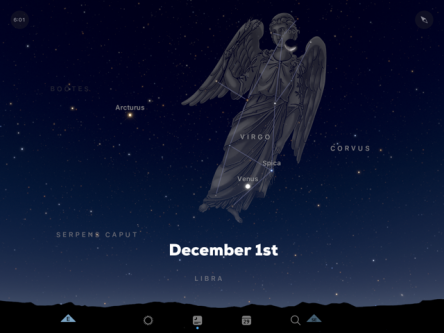
• DEC 1 – Venus, now a morning object, is at its brightest, shining at magnitude -4.9.
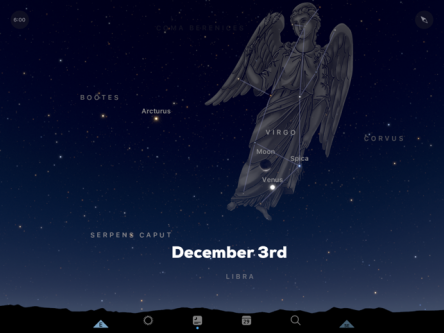
• DEC 3 – A waning crescent moon will be just above brilliant Venus in the morning sky. This will be a beautiful sight to behold so get out and look up.
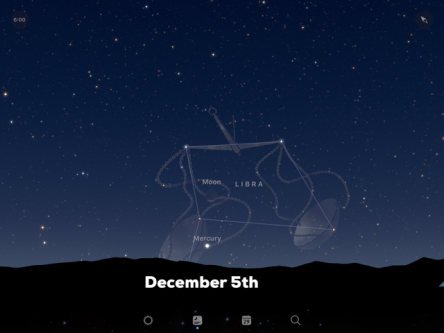
• DEC 5 – Look to the east at around 6:00 AM CST to see the waning crescent moon just above the planet Mercury very low to the horizon.
• DEC 7 – The moon is at new phase. Without its glare, now is a good time to observe faint deep sky objects with binoculars or a telescope. These conditions will prevail until around the time the moon reaches first quarter on the 15th, afterwards, it will once again begin to interfere with observing fainter sky objects.
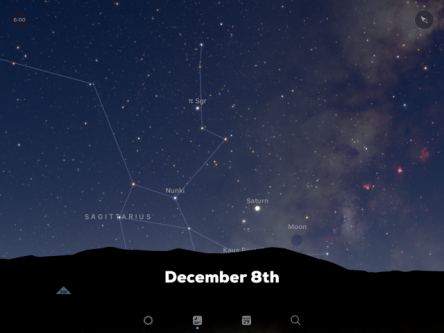
• DEC 8 – Look for the thin waxing crescent moon just to the right of Saturn right after sunset and very low to the SW horizon.
• DEC 11 – Annie Jump Cannon was born on this day in 1863. Astronomer Annie Jump Cannon was one of the many “women computers” who worked at the Harvard Observatory for Dr. Edward Pickering. 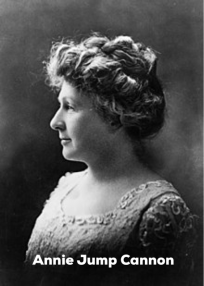 These women were tasked with sorting through tons of data that the male astronomers were gathering at a prodigious rate while working for very low wages. Few of the male astronomers are remembered today. But several of the women are. A few of the women employed at the observatory had exceptional talent as scientists and they made discoveries that changed our understanding of the universe. Cannon’s contribution was devising a classification scheme for stars based upon their temperature and spectral types. Her classification scheme is still used today, and it paved the way for our understanding of how stars evolve over time. She would go on to win many awards and accolades for her work and today, the American Astronomical Society gives out an award bearing her name to women who have made important contributions to the field of astronomy.
These women were tasked with sorting through tons of data that the male astronomers were gathering at a prodigious rate while working for very low wages. Few of the male astronomers are remembered today. But several of the women are. A few of the women employed at the observatory had exceptional talent as scientists and they made discoveries that changed our understanding of the universe. Cannon’s contribution was devising a classification scheme for stars based upon their temperature and spectral types. Her classification scheme is still used today, and it paved the way for our understanding of how stars evolve over time. She would go on to win many awards and accolades for her work and today, the American Astronomical Society gives out an award bearing her name to women who have made important contributions to the field of astronomy.
On this day in 1972, Apollo 17 lands on the moon. This was the last of the Apollo missions. The crew 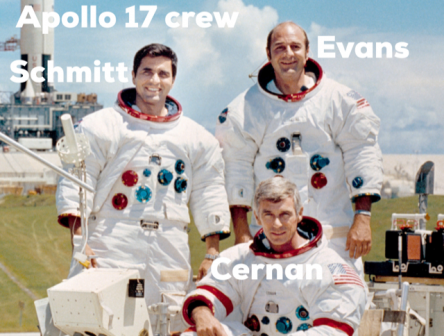 consisted of astronauts Gene Cernan, Ronald Evans, and Harrison Schmitt. Cernan and Schmitt were the last two human being to walk upon the lunar surface.
consisted of astronauts Gene Cernan, Ronald Evans, and Harrison Schmitt. Cernan and Schmitt were the last two human being to walk upon the lunar surface.
• DEC 12 – At 6:25 AM the moon is at apogee, its greatest distance for the month, 251,765 miles away.
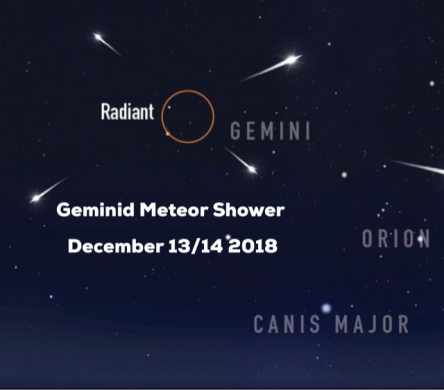 • DEC 13/14 AN OBSERVING HIGHLIGHT The Geminid Meteor Shower, one of the very best showers of the year, peaks during a moonless sky. The zenithal hourly rate is listed as being 120 meteors per hour but that is an idealized number that assumes perfect observing conditions. A more realistic number for the Geminids, seen under a dark rural sky, is about 80 meteors per hour at most. See the December feature for more information. In order to find a good observing location in Arkansas, be sure and visit the Arkansas Natural Sky Association website at: http://darkskyarkansas.com
• DEC 13/14 AN OBSERVING HIGHLIGHT The Geminid Meteor Shower, one of the very best showers of the year, peaks during a moonless sky. The zenithal hourly rate is listed as being 120 meteors per hour but that is an idealized number that assumes perfect observing conditions. A more realistic number for the Geminids, seen under a dark rural sky, is about 80 meteors per hour at most. See the December feature for more information. In order to find a good observing location in Arkansas, be sure and visit the Arkansas Natural Sky Association website at: http://darkskyarkansas.com
The waxing crescent moon can be seen just above Mars right after sunset towards the south. The moon will set before the meteor shower ramps up.
• DEC 15 – The moon is now at first quarter. Mercury is at its greatest western elongation (its greatest angular separation from the Sun at 21 degrees. Look for it this morning before sunrise in the east.
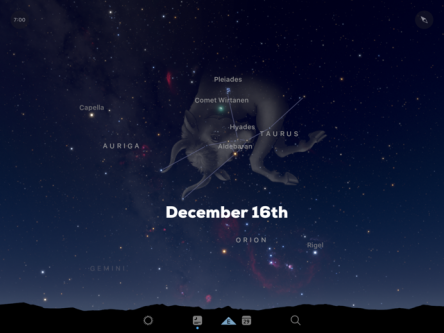
• DEC 16 AN OBSERVING HIGHLIGHT Comet 46P/Wirtanen can be seen near the Pleiades star cluster in the constellation of Taurus. See the December feature to learn more.

• DEC 20 – Look for the waxing crescent moon amid the Hyades, an open star cluster found within the face of Taurus the Bull.
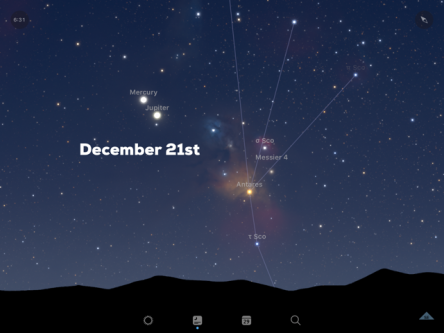
• DEC 21 – At around 6:30 AM, look to the southeast to see the planet Mercury about 1 degree above Jupiter. What an amazing planetary conjunction to see! Use binoculars to split the two.
The Winter Solstice in the Northern Hemisphere officially starts at 4:23 PM CST.
• DEC 22 – The moon is now at full phase.
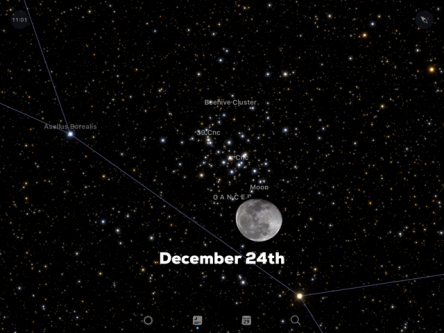
• DEC 24 – Look for the waning gibbous moon just to the south of the open star cluster Messier 44, the Beehive Cluster, in the constellation of Cancer.
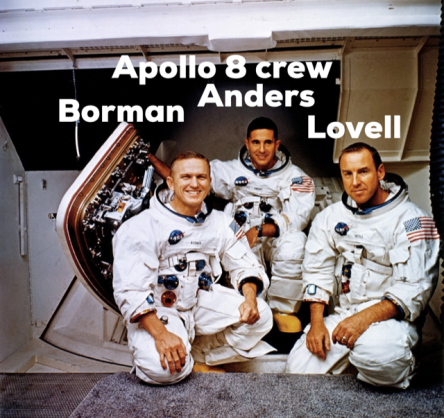
On this day in 1968, astronauts Frank Borman, Jim Lovell, and Bill Anders become the first human beings to orbit another world, the moon, aboard the Apollo 8 spacecraft. To learn more about this historic event, go here: https://www.nasa.gov/topics/history/features/apollo_8.html
• DEC 25 – Happy Holidays from all of us here at The Night Sky
• DEC 27 – Johannes Kepler, mathematician and astronomer, was born this day. Kepler is the man who worked out how the planets moved in their orbits around the Sun. His three laws of planetary motion were a groundbreaking achievement in our understanding of the universe and they would underpin Sir Isaac Newton’s equally groundbreaking work on universal gravitation.
is the man who worked out how the planets moved in their orbits around the Sun. His three laws of planetary motion were a groundbreaking achievement in our understanding of the universe and they would underpin Sir Isaac Newton’s equally groundbreaking work on universal gravitation.
• DEC 29 – The moon is now at last quarter.